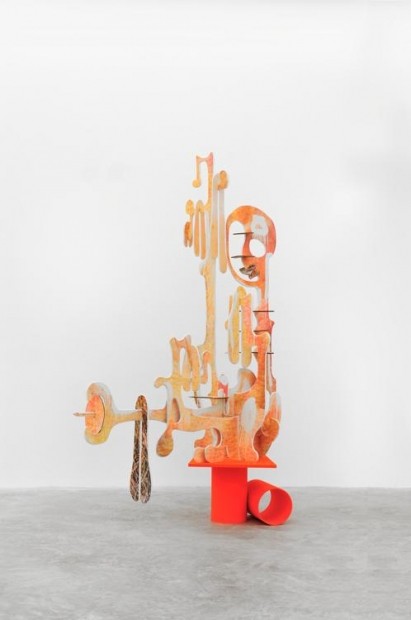Aaron Curry
12 Oct - 09 Nov 2013

© Aaron Curry
MUFF MOUTH, 2013
Ink, silkscreen, spray paint on wood with painted aluminium base
268 x 86,4 x 189,2 cm
MUFF MOUTH, 2013
Ink, silkscreen, spray paint on wood with painted aluminium base
268 x 86,4 x 189,2 cm
AARON CURRY
Newdz and New Godz
12 October - 9 November 2013
There came a time when the Old Gods died! – Jack Kirby
“NEWDZ AND NEW GODZ” presents an ensemble of new works by the American artist Aaron Curry. Organized around a graphic motif of skin and hair photographed at close range, the exhibition sets up a constellation of references, from the history of collage and the nude to the cadaver-craftwork of bodysnatcher Ed Gein and the amusements of childhood masquerade. Curry’s sculptures are composed from irregular wooden segments, slotted together and silkscreened with magnified views of his skin. Arranged like a hall of classical statuary, they invert the Pygmalion myth, flattening rather than animating the flesh printed on them, and confronting the promise of vitality couched in human skin with its morbid condition when reduced to merely surface. Recalling Picasso’s monstrous seaside bathers, they transform the nude—that token of fulfillment and contained desire—into a seemingly provisional and precarious assembly of fragments, alternately hidden in profile view and aggressively frontal.
Surfaces elsewhere in the gallery, however, have taken on the fleshy proximity that Curry has squeezed out of his sculptures. Like a stripped-down version of Gottfried Semper’s architectural Bekleidungstheorie, the rooms here are cladded in silkscreened panels of beards and skin. Alongside sculptures fabricated in rigid industrial materials that belie their spontaneous contours, the panels invoke an artistic history of mechanical reproduction. Here, seriality opens not onto sameness, but onto seemingly endless, even excessive variation, as pictorially unstable as the sculptures are volumetrically. The viewer stands surrounded by a sort of skin quilt that knits together Warhol and Leatherface, an interiority turned inside out and dilated to architectural proportions.
Curry’s work plays on the logic of collage—a collision of high art and down-home, rarefied and rural, Noguchi and Pappy Yokum, Westerman and Hee Haw. In “NEWDZ AND NEW GODZ,” the mass cultural references are more restrained, appearing principally in a series of tondos silkscreened with images of children from face-painting catalogues. The artist then alters these images so that the vaguely deranged poses of the masquerading children now ooze with violet excretions. Hung on a ground of grafted skin and hair, Curry’s faces are the foil to a new kind of body, one identified not through an inner life and its psychological particularity, but through a profusion of differences and samenesses—a collage principle, perhaps, for the psyche.
Joanna Fiduccia
Newdz and New Godz
12 October - 9 November 2013
There came a time when the Old Gods died! – Jack Kirby
“NEWDZ AND NEW GODZ” presents an ensemble of new works by the American artist Aaron Curry. Organized around a graphic motif of skin and hair photographed at close range, the exhibition sets up a constellation of references, from the history of collage and the nude to the cadaver-craftwork of bodysnatcher Ed Gein and the amusements of childhood masquerade. Curry’s sculptures are composed from irregular wooden segments, slotted together and silkscreened with magnified views of his skin. Arranged like a hall of classical statuary, they invert the Pygmalion myth, flattening rather than animating the flesh printed on them, and confronting the promise of vitality couched in human skin with its morbid condition when reduced to merely surface. Recalling Picasso’s monstrous seaside bathers, they transform the nude—that token of fulfillment and contained desire—into a seemingly provisional and precarious assembly of fragments, alternately hidden in profile view and aggressively frontal.
Surfaces elsewhere in the gallery, however, have taken on the fleshy proximity that Curry has squeezed out of his sculptures. Like a stripped-down version of Gottfried Semper’s architectural Bekleidungstheorie, the rooms here are cladded in silkscreened panels of beards and skin. Alongside sculptures fabricated in rigid industrial materials that belie their spontaneous contours, the panels invoke an artistic history of mechanical reproduction. Here, seriality opens not onto sameness, but onto seemingly endless, even excessive variation, as pictorially unstable as the sculptures are volumetrically. The viewer stands surrounded by a sort of skin quilt that knits together Warhol and Leatherface, an interiority turned inside out and dilated to architectural proportions.
Curry’s work plays on the logic of collage—a collision of high art and down-home, rarefied and rural, Noguchi and Pappy Yokum, Westerman and Hee Haw. In “NEWDZ AND NEW GODZ,” the mass cultural references are more restrained, appearing principally in a series of tondos silkscreened with images of children from face-painting catalogues. The artist then alters these images so that the vaguely deranged poses of the masquerading children now ooze with violet excretions. Hung on a ground of grafted skin and hair, Curry’s faces are the foil to a new kind of body, one identified not through an inner life and its psychological particularity, but through a profusion of differences and samenesses—a collage principle, perhaps, for the psyche.
Joanna Fiduccia
